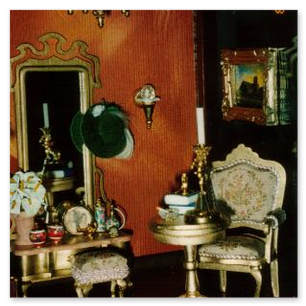Pépp & Órson
Interviews > Brazilians
Pépp Assis & Órson Luis
Your atelier is in São Paulo, are you both from here?
Pépp: I’m from Juiz de Fora, Minas Gerais.
Órson: I’m from Divinopolis, Minas Gerais
What is your professional backgroundl?
Pépp: I was an engineer at Eletropaulo.
Orson: I was a road construction technician.
How and when did you begin to work with miniatures?
We always liked arts and crafts. Órson used to make model buildings when he was a kid, even shoe boxes were used to make them! At some point we began to deal with antiques. We would travel to several states searching and buying pieces that we would later sell at flea markets in Sao Paulo. Once we came across some small furniture, they weren’t in 1:12th scale, they were somewhat bigger. We didn’t even know that scale back then. Some chairs were even broken, so Órson fixed them. People loved them! No one here knew much about miniatures back then. This happened about 20 years ago.
Was it then when it all began?
No, it still took a while. By then we had already set up an antiques shop in Moema, a neighborhood in Sao Paulo. But that was during "Plano Collor", the government economy measures which made everybody’s life difficult, specially for store owners. Then I talked Órson into making miniature replicas of the furniture at the store. For the price of one real size chair, which could take forever to be sold, we could easily sell 10 miniature replicas.
How did the public react to them?
Great acceptance. Those who had already seen miniatures in Europe and collected them would come to us to buy ours. After that, things progressed smoothly and fast. Our first exhibit took place six months after that. That’s how long it took us to make most of the roomboxes that are at display in our Studio. This was in September 1991, at Eletropaulo’s showroom. After that we had an even bigger exhibit at Shopping Paulista (a mall in Sao Paulo), in 1993. On the last day, people would stay in long lines at the mall halls just to get in. A huge success!
And what does each of you do exactly?
Pépp: I’m in charge of the design and I make the final details, the decoration. What I really like to do is to create, to come up with new, different things. I can’t do mass-production.
Órson: I make the furniture. I love to work with wood. And I usually make 12 of each right away.
Órson, which wood do you prefer to work with? And which tools?
The first chair I ever made was built from balsa. It’s really hard to give it a good finishing. Now I usually work with cedar. I’ve been giving it a try with MDF recently. My tools are all hand ones: jeweler’s saw, etc. I use a common power drill as lathe.
Pépp, your roomboxes are different from the ones we usually see around: all walls are glass panels.
When we started, roomboxes had only one glass wall, which made them very dark and hard to look into. We developed this kind of "open" roombox, where all the "walls" are made of a glass panel. We only put one "wall" on the back so that we can include some decoration details like a window, curtains, pictures, etc. I was also the first one to put miniatures in a frame. But a little after, cheap and low quality copies took over the market and I decided to give it a break.
But your miniatures are so amazing! Don’t you consider selling abroad, where they might be better appreciated?
We have already sold some commissioned work to a customer in Spain (the mall in a cabinet) and in other countries. But it isn’t simple. Those boxes are a delicate work, and usually some pieces get detached by the not so delicate handling during the shipping process, and might even get broken. The buyers, though, want our warranty that nothing will get broken. How could we? The mail system won’t even let us write "fragile" on the parcel!... Besides, the paper work (red tape) required is tremendous.
Is it possible to live off miniatures in Brazil?
No, it is not. Roomboxes take up a lot of room and people usually don’t have a clue of where to fit them in their houses. Besides, they’re quite expensive for Brazilian economical standards. On the other hand, the framed miniatures have better acceptance, as it’s much easier to fit them in any decoration style, and they’re more affordable. Now, small individual pieces, even though they are much cheaper, are only for those who collect them to put into their own roomboxes or dollhouses. This hobby is not part of your culture yet. And as they are more affordable, the market price for them isn’t worth the amount of hours spent making them manually.
What’s missing to make miniatures "catch on" in Brazil?
It’s becoming a lot better nowadays, as people are discovering this art. The taxes are a huge barrier, though, making it very difficult to keep a brick and mortar shop exclusively devoted to miniatures. Besides, the Chinese flooded the marked with their low-cost mass-production pieces, making it impossible to compete with them, even considering that the quality of our work is way higher. But above all, we lack coherence in production: a consistent historical knowledge transferred to the pieces, a standardized scale - any scale! - and a serious design study. In short, we lack organization.
What are your future projects?
Pépp: I want to create new framed miniatures. I would like to make more roomboxes, but I’ll need to have more free time for that.
Orson: Besides keeping on making miniatures, I’ve been thinking about teaching classes on how to make them. But we have find an adequate place for that first.








































































